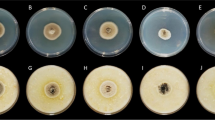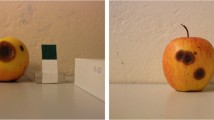Abstract
Due to climate change, Neofusicoccum parvum is currently emerging as a new pathogen of Rosaceae plant species. This increases the need of gaining knowledge on the pathogenicity of this fungus, particularly on apple cultivars of considerable economic importance. In this study, the virulence and temperature dependence of N. parvum isolates was assayed on ‘Gala’ and ‘Fuji’ apple fruit and wood. At 25 °C and 30 °C, ‘Gala’ fruits showed a higher susceptibility to all fungal strains than ‘Fuji’, whereas low infection severity was shown at 15 °C and 20 °C on both cultivars. Infrared spectroscopy revealed that ‘Fuji’ fruit tissues displayed a higher content of phenolic compounds and pectin esterification degree, as factors possibly correlated with fruit susceptibility. When strain virulence was assayed on wood, no significant difference in susceptibility was detected, as also shown by SEM analysis. The virulence of N. parvum was also tested by assaying the activity of lytic enzymes such as cellulase, polygalacturonase, polymethylgalacturonase, and xylanase.






Similar content being viewed by others
References
Abou-Mansour, E., Débieux, J. L., Ramírez-Suero, M., Bénard-Gellon, M., Magnin-Robert, M., Spagnolo, A., et al. (2015). Phytotoxic metabolites from Neofusicoccum parvum, a pathogen of Botryosphaeria dieback of grapevine. Phytochemistry. https://doi.org/10.1016/j.phytochem.2015.01.012.
Adesemoye, A. O., Mayorquin, J. S., Wang, D. H., Twizeyimana, M., Lynch, S. C., & Eskalen, A. (2014). Identification of species of Botryosphaeriaceae causing bot gummosis in citrus in California. Plant Disease. https://doi.org/10.1094/PDIS-05-13-0492-RE.
Amponsah, N. T., Jones, E. E., Ridgway, H. J., & Jaspers, M. V. (2008). Production of Botryosphaeria species conidia using grapevine green shoots. New Zealand Plant Protection, 61, 310–305.
Amponsah, N. T., Jones, E. E., Ridgway, H. J., & Jaspers, M. V. (2011). Identifcation, potential inoculum sources and pathogenicity of species of the Botryosphaeriaceae associated with grapevine dieback disease in New Zealand. European Journal of Plant Pathology. https://doi.org/10.1071/AP05018.
Ayers, W. A., Papavizas, G. C., Diem, A. F., Durrands, P. K., & Cooper, R. M. (1966). Polygalacturonate transeliminase and polyga-role of pectinases in vascular wilt disease as deterlacturonase production by Rhizoctonia solani. Phytopathology, 56, 1006–1011.
Barros, A. S., Mafra, I., Ferreira, D., Cardoso, S., Reis, A., Lopes de Silva, J. A., et al. (2002). Determination of the degree of methyl esterification of pectic polysaccharides by FT-IR using an outer product PLS1 regression. Carbohydrate Polymers. https://doi.org/10.1016/S0144-8617(02)00017-6.
Baskarathevan, J., Jaspers, M. V., Jones, E. E., & Ridgway, H. J. (2012). Development of isolate-specifc markers for Neofusicoccum parvum and N. luteum and their use to study rainwater splash dispersal in the vineyard. Plant Pathology. https://doi.org/10.1111/j.1365-3059.2012.02675.x.
Beckman, T. G., & Reilly, C. C. (2005). Relative susceptibility of peach cultivars to fungal gummosis (Botryosphaeria dothidea). Journal of the American Pomological Society., 59, 111–116.
Bertsch, C., Ramirez-Suero, M., Magnin-Robert, M., Larignon, P., Chong, J., Abou-Mansour, E., et al. (2013). Grapevine trunk diseases: Complex and still poorly understood. Plant Pathology. https://doi.org/10.1111/j.1365-3059.2012.02674.x.
Bonora, S., Francioso, O., Tugnoli, V., Prodi, A., Di Foggia, M., Righi, V., et al. (2009). Structural characteristics of ‘Hayward’ kiwifruit from elephantiasis-affected plants studied by DRIFT, FT-Raman, NMR, and SEM techniques. Journal of Agricultural and Food Chemistry. https://doi.org/10.1021/jf9002957.
Boyer, J., & Liu, R. H. (2004). Apple phytochemicals and their health benefits. Nutrition Journal. https://doi.org/10.1186/1475-2891-3-5.
Carlucci, A., Lops, F., Raimondo, M. L., Gentile, V., Mucci, M., & Frisullo, S. (2009). The Botryosphaeria species from vineyards of Apulia. Phytopathologia Mediterranea, 48, 180–180.
Chen, S. F., Morgan, D. P., Hasey, J. K., Anderson, K., & Michailides, T. J. (2014). Phylogeny, morphology, distribution, and pathogenicity of Botryosphaeriaceae and Diaporthaceae from English walnut in California. Plant Disease. https://doi.org/10.1094/PDIS-07-13-0706-RE.
Coakley, S. M., Scherm, H., & Chakraborty, S. (1999). Climate change and plant disease management. Annual Review of Phytopathology. https://doi.org/10.1146/annurev.phyto.37.1.399.
Delgado-Cerrone, L., Mondino, P., & Alaniz, S. (2016). Botryosphariaceae species associated with stem canker, die-back and fruit rot on apple in Uruguay. European Journal of Plant Pathology, 146, 637–655. https://doi.org/10.1007/s10658-016-0949-z.
Di Francesco, A., Ugolini, L., D’Aquino, S., Pagnotta, E., & Mari, M. (2017). Biocontrol of Monilinia laxa by Aureobasidium pullulans strains: Insights on competition for nutrients and space. International Journal of Food Microbiology. https://doi.org/10.1016/j.ijfoodmicro.2017.02.007.
Di Francesco, A., Mari, M., & Roberti, R. (2018). Defense response against postharvest pathogens in hot water treated apples. Scientia Horticulturae. https://doi.org/10.1016/j.scienta.2017.09.039.
Di Francesco, A., Cameldi, I., Neri, F., Barbanti, L., Folchi, A., Spadoni, A., & Baraldi, E. (2019). Effect of apple cultivars and storage periods on the virulence of Neofabraea spp. Plant Pathology. https://doi.org/10.1111/ppa.13074.
Durrands, P. K., & Cooper, R. M. (1988). Selection and characterization of pectinase-deficient mutans of the vascular wilt pathogen Verticilliumablo-atrum. Physiological and Molecular Plant Pathology. https://doi.org/10.1016/S0885-5765(88)80029-8.
Eriksson, K., & Petterson, B. (1975). Extracellular enzyme system utilized by the fungus Sporotrichum pulverulentum (Chrysosporium lignorum) for the breakdown of cellulose. European Journal of Biochemistry, 51, 193–206.
Esteves, A. C., Saraiva, M., Correia, A., & Alves, A. (2014). Botryosphaeriales fungi produce extracellular enzymes with 2 biotechnological potential. Canadian Journal of Microbiology. https://doi.org/10.1139/cjm-2014-0134.
Fernandes, I., Alves, A., Correia, A., Devreese, B., & Esteves, A. C. (2014). Secretome analysis identifies potential virulence factors of Diplodia corticola, a fungal pathogen involved in cork oak (Quercus suber) decline. Fungal Biology. https://doi.org/10.1016/j.funbio.2014.04.006.
Hansen, J., Sato, M., Kharecha, P., Russell, G., Lea, D. W., Siddall, M. (2007). Climate change and trace gases. Philosophical transactions. Series A, mathematical, physical, and engineering sciences, https://doi.org/10.1098/rsta.2007.2052.
Heneczowski, M., Kopacz, M., Nowak, D., & Kuzniar, A. (2001). Infrared spectrum analysis of some flavonoids. Acta Poloniae Pharmaceutica, 58, 415–420.
Iotti, M., & Zambonelli, A. (2006). A quick and precise technique for identifying ectomycorrhizas by PCR. Mycological Research, 110, 60–65.
Javier-Alva, J., Gramaje, D., Alvarez, L. A., & Armengol, J. (2009). First report of Neofusicoccum parvum associated with dieback of mango trees in Peru. Plant Disease. https://doi.org/10.1094/PDIS-93-4-0426B.
Khon, F. C., & Hendrix, F. F. (1983). Influence of sugar content and pH on development of white rot on apples. Plant Disease, 67, 410–412.
Kikot, G. E., Hours, R. A., & Alconada, T. M. (2009). Contribution of cell wall degrading enzymes to pathogenesis of Fusarium graminearum: A review. Journal of Basic Microbiology. https://doi.org/10.1002/jobm.200800231.
Lambert, C., Bisson, J., Waffo-Teguo, P., Papastamoulis, Y., Richard, T., Corio-Costet, M. F., et al. (2012). Phenolics and their antifungal role in grapevine wood decay: Focus on the Botryosphaeriaceae family. Journal of Agricultural and Food Chemistry. https://doi.org/10.1021/jf303290g.
Lionetti, V., Cervone, F., & Bellincampi, D. (2012). Methyl esterification of pectin plays a role during plant-pathogen interactions and affects plant resistance to diseases. Journal of Plant Physiology. https://doi.org/10.1016/j.jplph.2012.05.006.
Luque, J., Martos, S., Aroca, A., Raposo, R., & Garcia-Figueres, F. (2009). Symptoms and fungi associated with declining mature grapevine plants in Northeast Spain. Journal of Plant Pathology. https://doi.org/10.4454/jpp.v91i2.968.
Marques, M. W., Lima, N. B., Morais Jr., M. A., Barbosa, M. A. G., Souza, B. O., Michereff, S. J., et al. (2013). Species of Lasiodiplodia associated with mango in Brazil. Fungal Diversity. https://doi.org/10.1007/s13225-013-0231-z.
Melzer, R. R., & Berton, O. (1986). Incidência de Botryosphaeria berengeriana cultura da macieira (Malus domestica) no estado de Santa Catarina, Brasil. Fitopatologia Brasileira., 11, 891–898.
Molina-Gayosso, E., Silva-Rojas, H. V., García-Morales, S., & Avila-Quezada, G. (2012). First report of black spots on avocado fruit caused by Neofusicoccum parvum in Mexico. Plant Disease. https://doi.org/10.1094/PDIS-08-11-0699.
Mugnai, L., Surico, G., & Sfalanga, A. (1997). Produzione di enzimi esocellulari da parte di funghi del legno di viti colpite da “mal dell’esca”. Micologia italiana., 1, 11–22.
Mugnai, L., Graniti, A., & Surico, G. (1999). Esca (black measles) and brown wood streaking two old and elusive diseases of grapevines. Plant Disease. https://doi.org/10.1094/PDIS.1999.83.5.404.
Pérez, C. A., Wingfield, M. J., Slippers, B., Altier, N. A., & Blanchette, R. A. (2010). Endophytic and canker-associated Botryosphaeriaceae occurring on non-native Eucalyptus and native Myrtaceae trees in Uruguay. Fungal Diversity. https://doi.org/10.1007/s13225-009-0014-8.
Phillips, A. J. L., Alves, A., Abdollahzadeh, J., Slippers, B., Wingfield, M. J., Groenewald, J. Z., et al. (2013). The Botryosphaeriaceae: Genera and species known from culture. Studies in Micology. https://doi.org/10.3114/sim0021.
Prodorutti, D., Cainelli, C., Gualandri, V., Profaizer, D., Dallago, A., Branz, A., et al. (2012). Moria e deperimento del melo in Trentino. Atti Giornate Fitopatologiche, 2, 619–620.
Ramírez-Suero, M., Chong, J., Farine, S., Kiefe-Mazet, F., Pensec, F., Gacougnole, I., et al. (2012). Effect of Neofusicoccum parvum and Diplodia seriata extra-cellular compounds on defence gene expression in Vitis vinifera cv. Chardonnay and cv. Gewurztraminer. Phytopathologia Mediterranea, 51, 438–438.
Sakalidis, M. L., Hardy, G. E. S. J., & Burgess, T. I. (2011). Class III endophytes, clandestine movement amongst hosts and habitats and their potential for disease; a focus on Neofusicoccum australe. Australasian Plant Pathology, 40, 510–521. https://doi.org/10.1007/s13313-011-0077-3.
Sakalidis, M. L., Slippers, B., Wingfield, B. D., G. E. St. J. Hardy, Burgess, T. I. (2013). The challenge of understanding the origin, pathways and extent of fungal invasions: global populations of the Neofusicoccum parvum–N. ribis species complex. Diversity and Distributions, https://doi.org/10.1111/ddi.12030.
Schneider, C. A., Rasband, W. S., & Eliceiri, K. W. (2012). NIH image to ImageJ: 25 years of image analysis. Nature Methods, 9, 671–675 PMID: 22930834.
Schulz, H., & Baranska, M. (2007). Identification and quantification of valuable plant substances by IR and Raman spectroscopy. Vibrational Spectroscopy. https://doi.org/10.1016/j.vibspec.2006.06.001.
Slippers, B., & Wingfield, M. J. (2007). Botryosphaeriaceae as endophytes and latent pathogens of woody plants: Diversity, ecology and impact. Fungal Biology Reviews. https://doi.org/10.1016/j.fbr.2007.06.002.
Slippers, B., Smit, A., Crous, P. W., Countinho, T. A., Wingfield, B. D., & Wingfield, M. J. (2007). Taxonomy, phylogeny and identification of Botryosphaeriaceae associated with pome and stone fruit trees in South Africa and other regions of the world. Plant Pathology. https://doi.org/10.1111/j.1365-3059.2006.01486.x.
Slippers, B., Boissin, E., Phillips, A. J. L., Groenewald, J. Z., Wingfield, M. J., Postma, A., et al. (2013). Phylogenetic lineages in the Botryosphaeriales: A systematic and evolutionary framework. Studies in Mycology, https://doi.org/10.3114/sim0020.
Spagnolo, A., Marchi, G., Peduto, F., Phillips, A. J. L., & Surico, G. (2011). Detection of Botryosphaeriaceae species within grapevine woody tissues by nested PCR, with particular emphasis on the Neofusicoccum parvum/N. ribis complex. European Journal of Plant Pathology. https://doi.org/10.1007/s10658-010-9715-9.
Spagnolo, A., Larignon, P., Magnin-Robert, M., Hovasse, A., Cilindre, C., Van Dorsselaer, A., et al. (2014). Flowering as the most highly sensitive period of grapevine (Vitis vinifera L. cv Mourvèdre) to the Botryosphaeria dieback agents Neofusicoccum parvum and Diplodia seriata infection. International Journal of Molecular Sciences. https://doi.org/10.3390/ijms15069644.
Spotts, R. A., Cervantes, L. A., & Mielke, E. A. (1999). Variability in postharvest decay among apple cultivars. Plant Disease. https://doi.org/10.1094/PDIS.1999.83.11.1051.
Srivastava, P., Andersen, P. C., Marois, J. J., Wright, D. L., Srivastava, M., & Harmon, P. F. (2013). Effect of phenolic compounds on growth and ligninolytic enzyme production in Botryosphaeria isolates. Crop Protection. https://doi.org/10.1016/j.cropro.2012.09.015.
St Leger, R. J., Joshi, L., & Roberts, D. W. (1997). Adaptation of proteases and carbohydrases of saprophytic: Phytopathogenic and entomopathogenic fungi to the requirements of their ecological niches. Microbiology, 143, 1983–1992.
Stempien, E. (2017). Grapevine Botryosphaeria dieback fungi have specific aggressiveness factor repertory involved in wood decay and stilbene metabolization. PLoS One. https://doi.org/10.1371/journal.pone.0188766.
Synytsya, A., Copikova, J., Matejka, P., & Machovic, V. (2003). Fourier transform Raman and infrared spectroscopy of pectins. Carbohydrate Polymers. https://doi.org/10.1016/S0144-8617(03)00158-9.
Taylor, A., Hardy, G. E. St. J., Wood, P., & Burgess, T. (2005). Identification and pathogenicity of Botryosphaeria species associated with grapevine decline in Western Australia. Australasian Plant Pathology. https://doi.org/10.1071/AP05018.
Úrbez-Torres, J. R. (2011). The status of Botryosphaeriaceae species infecting grapevines. Phytopathologia Mediterranea. https://doi.org/10.14601/Phytopathol_Mediterr-9316.
Vallette-Collet, O., Cimerman, A., Reignault, P., Levis, C., & Boccara, M. (2003). Disruption of Botrytis cinerea pectin methyl esterase gene Bcpme I reduces virulence on several host plants. Molecular Plant-Microbe Interactions. https://doi.org/10.1094/MPMI.2003.16.4.360.
Yang, Y. L., Turner, J., Stephens, J., Campbell, R. E., & Walter, M. (2017). Comparison of in vitro and in planta sporogenesis in Neofusicoccum species from blueberry. New Zealand Plant Protection, 70, 203–208.
Author information
Authors and Affiliations
Corresponding author
Ethics declarations
Conflict of interest
This work was not financed by grants. The authors declare no conflict of interest. This article does not contain any work conducted on animal or human participants.
Rights and permissions
About this article
Cite this article
Di Francesco, A., Rusin, C., Di Foggia, M. et al. Characterization of apple cultivar susceptibility to Neofusicoccum parvum Brazilian strains. Eur J Plant Pathol 156, 939–951 (2020). https://doi.org/10.1007/s10658-020-01945-7
Accepted:
Published:
Issue Date:
DOI: https://doi.org/10.1007/s10658-020-01945-7




